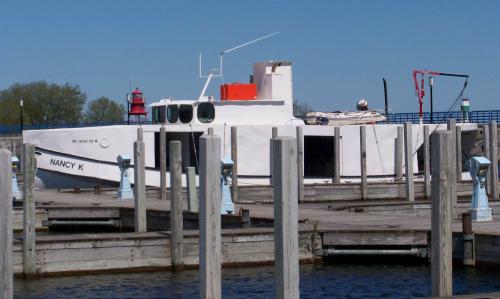Students study microplastics: Smallest of marine debris but big Great Lakes issue
You may be surprised to learn about the plastic floating throughout our lakes.

Over time, plastic pollution in our environment breaks down into smaller and smaller plastic fragments, also known as microplastics. These small pieces of plastic absorb pollutants and can be consumed by fish and birds resulting in harm. In general, marine debris is a growing issue and concern in our world’s oceans but also here at home in our freshwater seas – the Great Lakes.
To better understand this issue, Alpena High School ninth-grade chemistry students, in cooperation with Great Lakes’ scientists, are researching plastic pollution in Thunder Bay and Lake Huron. Using a surface trawl (a research net designed to sample plastic pollution) students have collected water samples onboard the glass bottom boat, Lady Michigan, over the past two school years. These samples were then analyzed in the school chemistry lab. While on the water, students also conducted some field-based water chemistry analysis and learned about biological pollution – aquatic invasive species – affecting the health of Lake Huron ecosystems.
In 2015, the students partnered with David Brooks, the owner and captain of the Nancy K, a retired commercial fishing vessel retrofitted to assist university and citizen scientists in researching microplastics in the Great Lakes. While onboard, a select group of Alpena High School students collected surface water samples and charted sample locations. The water samples were analyzed in the classroom as part of the students’ chemistry class.
The idea for this student-led plastic pollution research opportunity was developed by Alpena High School teacher Melissa Smith during the 2013 Lake Huron Summer Place-Based Education Institute, a workshop put on by the Northeast Michigan Great Lakes Stewardship Initiative. Sponsored by the Sea Grant Center for Great Lakes Literacy (CGLL), Great Lakes NOAA B-WET program, and the Great Lakes Fishery Trust, this workshop connected educators and scientists to help teachers learn to engage students in locally relevant Great Lakes stewardship projects. It was here that Smith first connected with Dr. Sherri Mason, a leading of Great Lakes plastic pollution researcher at Fredonia State University in New York. Smith later participated in hands-on microplastic research while working alongside Dr. Mason aboard an EPA research vessel as part the Great Lakes Shipboard Science Program, another CGLL-sponsored learning opportunity for teachers.
Putting this project into action, Smith’s students have made community connections through their research supported by the NOAA B-WET water education initiative and the NE MI GLSI network. Today, Smith’s class is conducting studies in partnership with Michigan Sea Grant, Michigan State University Extension, NOAA Thunder Bay National Marine Sanctuary, David Brooks and his team of citizen scientist volunteers and others.
By working with Great Lakes scientists and connecting communities these students are contributing scientific information about plastic pollution in Lake Huron while raising awareness about marine debris in their local watershed. The class plans to become more involved in addressing the issue of plastics entering the Great Lakes by promoting marine debris prevention opportunities locally. They hope to educate and involve their community as partners in exploring ways to reduce and prevent plastic debris from entering the waterways.
You, too, can help keep microplastics out of area watersheds. Starting with your personal care products, you might consider avoiding those that contain:
- Polyethylene (PE)
- Polypropylene (PP)
- Polyethylene terephthalate (PET)
- Polymethyl Methacrylate (PMMA)
In Alpena this summer? Join the team of citizen scientists on the Nancy K investigating and trawling for microplastics in Thunder Bay and Lake Huron. To join the team, contact David Brooks at dhbrooks@umich.edu or (734) 476-2144.
Michigan Sea Grant helps to foster economic growth and protect Michigan’s coastal, Great Lakes resources through education, research and outreach. A collaborative effort of the University of Michigan and Michigan State University, Michigan Sea Grant is part of the NOAA-National Sea Grant network of 33 university-based programs.



 Print
Print Email
Email

